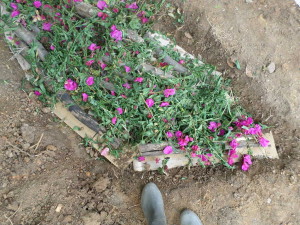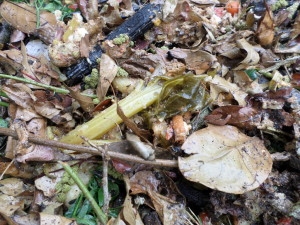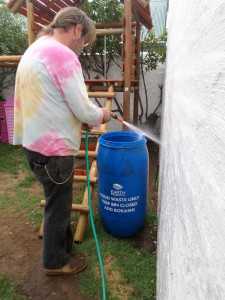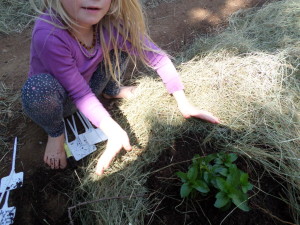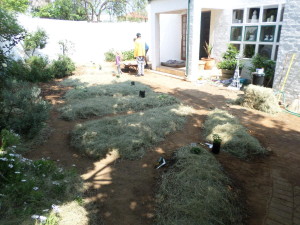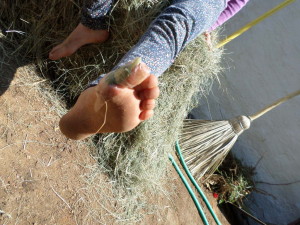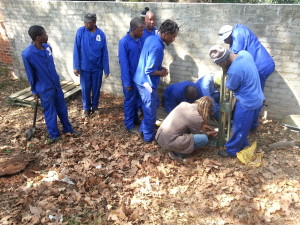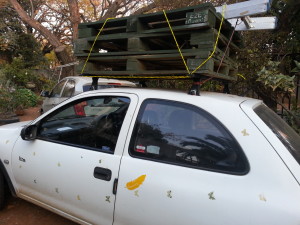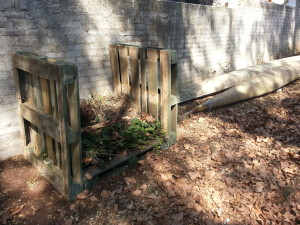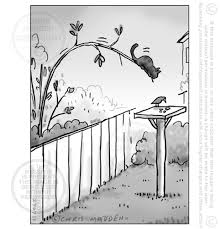Monthly Archives: September 2015
This past month I have been going to see people and walk about their gardens, I have typed up reports, recommending plants according to the families’ dietary requirements. The Suburban Farmer, Gary Dembo, assisted me in getting around and getting materials and labor to site, and put up the fence in the end. I can be reached as always, on 072 146 9017 for a consultation and report. Gary can be reached on 078 148 6588 if you interested in having our input.
Our journey with our first client has been awesome. We did this garden in less than 2 days, and the family already invited us back to continue by doing workshops for the neighbors, before we were done ![]()
Step 1 was to do the layout of the beds for the guys to dig into.
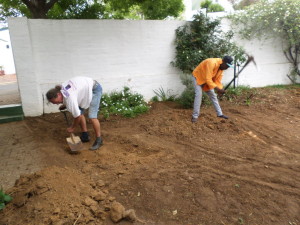 While they were digging I was ripping apart cardboard boxes and layering them into the dug up beds with logs on top.
While they were digging I was ripping apart cardboard boxes and layering them into the dug up beds with logs on top.
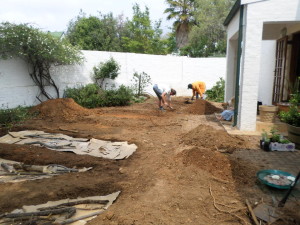 The next layers were green waste – we found bags of pruned bougainvilleas – made it look like a pie.
The next layers were green waste – we found bags of pruned bougainvilleas – made it look like a pie.
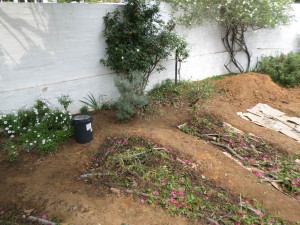 Next we layered fermented or bokashied food waste, and then soil and compost mixed. These layers ensure that all bacteria and micro-organisms required to breakdown the solid waste such as wood can co-exist under the food growing and thereby enhance the health of the soil. Thus also reducing the need for fertilizer or anit-pest through the season.
Next we layered fermented or bokashied food waste, and then soil and compost mixed. These layers ensure that all bacteria and micro-organisms required to breakdown the solid waste such as wood can co-exist under the food growing and thereby enhance the health of the soil. Thus also reducing the need for fertilizer or anit-pest through the season.
Thumbs up to Earth Probiotic and the good work they do – go like their page, alternatively you can purchase Bokash buckets and drums with me, or sign up as a restaurant to up-cycle your food waste.
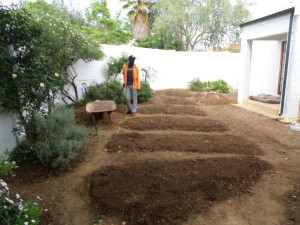 Then came mulching, we encouraged the families little girl to join in, and had alot of fun on this part…
Then came mulching, we encouraged the families little girl to join in, and had alot of fun on this part…
And we made use of the happy couples’ new plant WILD SAGE – also known as Mother Natures’ Plaster… feels soft like velvet, absorbs blood and has antiseptic properties… a true asset to any garden ![]()
and in the end ![]()
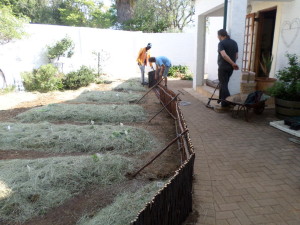 Im really looking forward to getting back into this space for a workshop, and planting up seeds tomorrow for this family, next full moon it is their turn and perhaps even SEED PLANTING according to the lunar calendar time too.
Im really looking forward to getting back into this space for a workshop, and planting up seeds tomorrow for this family, next full moon it is their turn and perhaps even SEED PLANTING according to the lunar calendar time too.
Don’t forget, our reports and quotations include options, and are suited to your budget.
I have done a workshop or two with great results and some with bad results. When St David’s Marist Inanda contacted me to train a few staff members, I did more research and came up with some notes and a worksheet for the staff.
I think its important information to share and process freely, and am more than happy to give more workshops at schools and sports grounds for staff wanting to grow their own food and medicine. I also advise on nutrient and carbon content plants to grow as green layers for the compost, some of which are ingredients in making either anti-pest or fertilizer for the garden. That, however is a different workshop. Please contact me, Netanya, on 072 146 9017 to make a workshop date in the Johannesburg area.
So, here is some important information to share:
What is the purpose of Composting?
• Composting is a way to reduce waste by re-using organic materials to recycle nutrients as a soil conditioner or multi-vitamin.
• Compost is the result of organic materials e.g. branches, leaves, food waste decomposing under controlled conditions.
• Compost is super – food for plants
Controlled conditions means YOU need to monitor the compost piles. If you maintain a pile with the correct moisture, air and carbon and nitrogen contents of the raw materials, then the decomposing organisms – insects, worms, bacteria and fungi do the rest.
What are carbon and nitrogen contents and why do we need them?
The organisms – insects, worms, bacteria and fungi depend on a ‘diet’ to survive. It is your job to take care of them, if you want to grow soil. They need nitrogen and carbon to survive.
This is important because the key to making great compost is to combine the right amount of moisture, and aeration with carbon and nitrogen materials in one pile. This means that making compost is like layering ingredients or materials in a dish of lasagna. It is in layers.
Maintenance of the Compost Pile
1. Cover the pile when it rains to prevent it from getting too wet or losing nutrients
2. Turn the heap regularly (every week or two) Building the pile on top of a palette allows air flow from below the pile which means you will need to turn the heap less regularly. A smelly compost heap tells us that it needs oxygen, it means it is time to turn the heap.
3. Water the heap in dry conditions
4. Chop or shred the leaves, twigs and other materials to speed up the decomposition process.
5. Be careful, it can get hot in there ![]()
This is the year of the soil, to some of us, it is perfect timing to prepare for a new earth as more and more people begin to implement permaculture gardening principles, earth heals. Healthy earth means a higher yield, stronger plants and far more than we can fathom ![]()
One of my first visits to a garden as a consultant, took me to a beautiful couples’ home who have cats. This is the first time someone has asked me for a anti-pest for cats. The lady told me that orange skins work but are not good for the soil or worms, which led me to google a bit and ask around.
To repel cats one can indeed, place orange peels cut face up near plants. Orange peels are acidic and tend to burn into the skins of worms, causing severe burns, and death to the worms, but they usually are deeper into the soil than close to the surface. This should be safe for the worms.
You can also mix 10 drops of lavender oil and/or 10 drops of eucalyptus oil in 200mls of water and spray on mulch and rocks in the garden as needed.
Making use of rough material such as sharp edged wood-chip or twig-mulch as a border or perimeter is also recommended as a repellent.
Another solution is to interplant your garden with plants that cats hate the smell of. A few of these plants can be planted in between the other plants of your garden, making the entire area seem disgusting to the local feline population.
- Rue is an especially effective cat repellent. It also repels wasps from fruit trees, and is an excellent ingredient in a tisane as it has muscle relaxant properties, and is also an aphrodesiac… making it even more perfect for this young couples solution

- Other options include lavender, pennyroyal, geranium, and lemon thyme.
- Scatter the dried version or dab on an oiled version to the same effect.
- Cayenne pepper, dry mustard, cinnamon, and garlic powder are often used, as well.
- As for oils, consider using lavender oil, lemon grass oil, citronella oil, peppermint oil, eucalyptus oil, or mustard oil.
I also discovered that it is useful to sprinkle coffee grounds for the purpose of deterring cats as well, as you own hair cuttings. Empty your hairbrushes into the garden, because the scent of human hair really sucks in cat world. Cats actually love mint, honeysuckle and catnip. Why not plant a small, cat-friendly area in the garden?
If you have enjoyed this post and are in the Johannesburg area, and would like to have me over for a consultation, report and quotation to improve the self sustainability of your home and surrounds please contact me – Netanya on 072 146 9017
